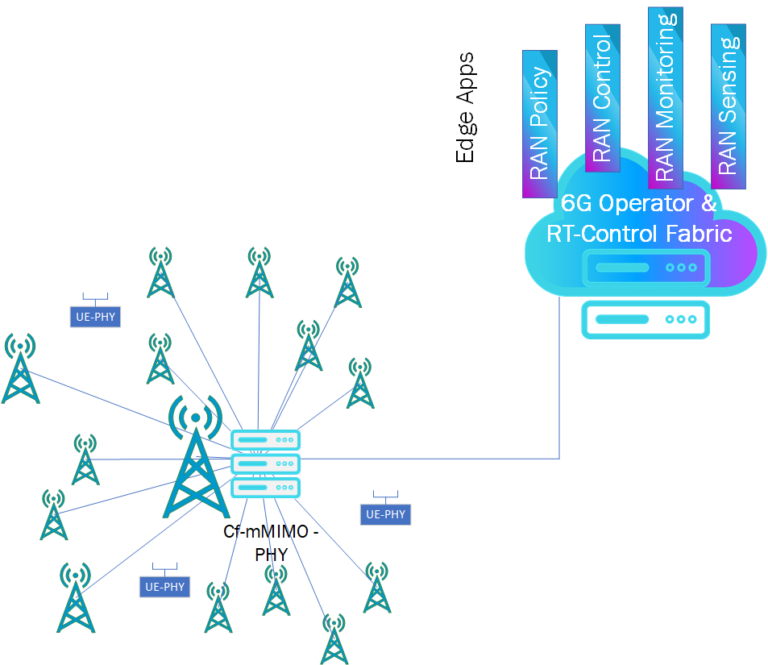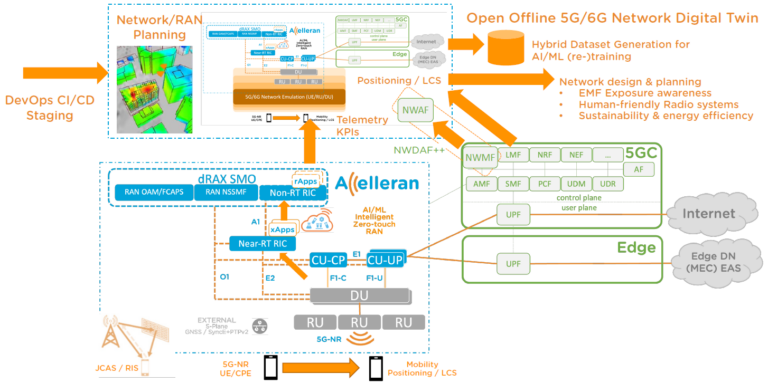PoC #1 — 5G+ Prototype
In this PoC, we will build an end-to-end small-scale proof-of-concept prototype to demonstrate performance and energy efficiency of Integrated Sensing and Communication (ISAC) in a form of an operated RU, DU, and CU/UPF pools with a real-time control fabric providing sub-millisecond control loop over each network component.
The PoC includes the following components:
1) a Service Management Orchestrator (SMO) will be used to facilitate validation and experimentation
and provide reproducibility;
2) a network of RUs forming Cell-Free massive MIMO (CF-mMIMO) are connected to the OAI-based disaggregated
RAN and CN network functions in a form of container images;
3) real-time control fabrics enriched with five JSAC control logics including spectrum management, RAN sensing, RAN monitoring, RAN control, and user positioning enhanced with CN location management functions (LMF) deployed as edge applications, i.e. xApps; and
4) 5G optimized compute nodes all synchronized using IEEE 1588v2 Precision Time Protocol (PTP). These components are represented in the figure.
The envisioned PoC is unique in that it is an end-to-end real-world testbed exhibiting 6G JSAC capabilities. We will experimentally measure and assess the performance and energy improvement in different deployment scenarios up to the TRL 4 considering different user spatio-temporal connectivity and traffic patterns. One particular scenario would be dynamic adaptation of CF-mMIMO to the current user activities controlled via edge applications.
PoC #2 — 6G CF-mMIMO PHY prototype with real-time control loop
Based on the previous figure, and leveraging the capabilities of a set of WATs in the RU Pool, i.e. Sub-6 and mmWave devices, we deploy a 6G CF-mMIMO PHY prototype and extend it to support real-time control loop (Figure on the right). The proposed prototype comprises of the Sub-6 and mmWave APUs. Additionally, it comprises the following components:
– BS and UE cf-mMIMO PHY layer able to establish a data plane and expose interfaces to be monitored and controlled.
– RAN RT control fabric enabling realtime RAN sensing, and control.
– Edge applications providing logics for RAN sensing, and controlling, e.g. instructing each AP to be active or passive (on/off strategy similar to phantom cells)
PoC #3 — 5G/6G Offline (online) Network Digital Twin
A network digital twin allows the assessment of configurations, methods and algorithms prior to their application in the network under evaluation, and allows predicting its performance under different conditions. It resembles a zero-risk environment where the network can undergo diagnose and emulation without impacting the real network. This concept enables the training of ML solutions to optimize the RAN PHY processing, e.g. using Reinforcement Learning as a decision-making tool.
In the context of 5G/6G offline and online network digital twin, the project will leverage a variety of WATs to ingest cross-technology sensing, telemetry, and control into the evolved 6G RIC. The goal is to enable efficient management and optimization of heterogeneous networks with multiple WATs, each with its own unique characteristics and performance capabilities.
To achieve this, the project will focus on the injection of native 3GPP LCS/Positioning from the LMF into the 5GNR OAI-based RIC, and potentially direct Near-RT injection into Near-RT RIC via E2+. The O-RAN RIC will also be extended to support cross-domain integration of Non-3GPP RAT control-plane and injection of Wi-Fi sensing for Sub-6 and mmWave networks (see Figure 14). Wi-Fi sensing using active sensing technology can be used for indoor sensing of human proximity and approximate location. This context can be injected into the sensing system, and will help extend the reach of JCAS sensing systems. With these enhancements, the project aims to enable real-time network monitoring, control, and optimization to achieve superior network performance and user experience.
Moreover, the project will explore the potential of multi-RAT JCAS to further enhance network performance and reliability. By leveraging advanced sensing capabilities across different wireless domains, including non-3GPP RATs such as Wi-Fi 7/8, the project aims to improve the accuracy and reliability of network sensing and monitoring. This will enable proactive network management and optimization to mitigate potential issues and ensure seamless service delivery.



